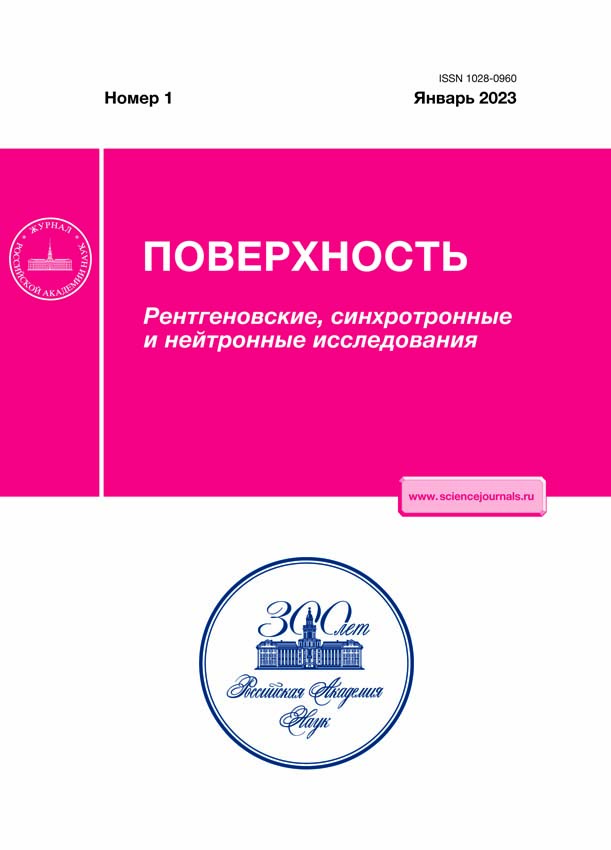Changes in the Morphology and Strength Properties of the Vanadium Surface under the Influence of Helium Ions and Pulsed Laser Irradiation
- Authors: Borovitskaya I.V.1, Korshunov S.N.2, Mansurova А.N.2, Bondarenko G.G.3, Gaidar A.I.4, Matveev E.V.4, Kazilin E.E.1
-
Affiliations:
- A.A. Baikov Institute of Metallurgy and Material Science RAS
- National Research Center “Kurchatov Institute”
- National Research University Higher School of Economics
- Research Institute of Advanced Materials and Technology
- Issue: No 1 (2023)
- Pages: 67-73
- Section: Articles
- URL: https://journals.rcsi.science/1028-0960/article/view/137661
- DOI: https://doi.org/10.31857/S1028096023010089
- EDN: https://elibrary.ru/BLAMYR
- ID: 137661
Cite item
Abstract
The effect of high-power pulsed laser irradiation generated in a GOS 1001 installation in the Q-switched mode (power density q = 1.2 × 1012 W/m2, pulse duration τ0 = 50 ns, number of pulses N = 1–4) in vacuum on a porous structure of the vanadium sample surface is studied, as well as on its hardness determined in two ways based on the recovered print method and on the kinetic indentation method. The porous structure is formed during implantation of helium ions (energy 30 keV, dose 2.0 × 1023 m–2, ion flux density 4.8 × 1018 m–2 · s–1, temperature ~500 K). It is shown that irradiation with helium ions causes vanadium hardening by about a factor of two, and the microhardness values determined by the recovered print method are slightly lower than the kinetic hardness values. It is found that in both cases, as a result of the target destruction under the laser radiation, a crater appears, surrounded by a breastwork, behind which there is a zone of thermal influence. Erosion is observed in this zone, caused by the destruction of the domes of bubbles-blisters filled with implanted helium and impurity atoms (C, O, N) present in the liquid metal. It is found that with an increase in the number of laser pulses, the microhardness in the crater decreases, while the narrow area around it hardens, and with further distance from the crater, the microhardness approaches values corresponding to that of vanadium implanted with helium ions.
About the authors
I. V. Borovitskaya
A.A. Baikov Institute of Metallurgy and Material Science RAS
Author for correspondence.
Email: symp@imet.ac.ru
Russia, 119334, Moscow
S. N. Korshunov
National Research Center “Kurchatov Institute”
Email: ang.2008@mail.ru
Russia, 123182, Moscow
А. N. Mansurova
National Research Center “Kurchatov Institute”
Author for correspondence.
Email: ang.2008@mail.ru
Russia, 123182, Moscow
G. G. Bondarenko
National Research University Higher School of Economics
Email: ang.2008@mail.ru
Russia, 101000, Moscow
A. I. Gaidar
Research Institute of Advanced Materials and Technology
Email: ang.2008@mail.ru
Russia, 115054, Moscow
E. V. Matveev
Research Institute of Advanced Materials and Technology
Email: ang.2008@mail.ru
Russia, 115054, Moscow
E. E. Kazilin
A.A. Baikov Institute of Metallurgy and Material Science RAS
Email: ang.2008@mail.ru
Russia, 119334, Moscow
References
- Гусева М.И., Мартыненко Ю.В. // Успехи физических наук. 1981. Т. 135. Вып. 4. С. 671.
- Бондаренко Г.Г. Радиационная физика, структура и прочность твердых тел: учебное пособие. М.: Лаборатория знаний, 2016. 462 с.
- Боровицкая И.В., Коршунов С.Н., Мансурова А.Н. и др. // Поверхность. Рентген., синхротр. и нейтрон. исслед. 2020. № 5. С. 56.
- Боровицкая И.В., Коршунов С.Н., Мансурова А.Н. и др. // Поверхность. Рентген., синхротр. и нейтрон. исслед. 2021. № 4. С. 25.
- Гусев В.М., Бушаров Н.П., Нафтулин С.М., Проничев А.М. // Приборы и техника эксперимента. 1969. Т. 4. С. 19.
- ГОСТ Р 8.748-2011 (ИСО 14 577-1: 2002). Металлы и сплавы. Измерение твердости и других характеристик материалов при инструментальном индентировании. М.: Стандартинформ, 2013.
- ГOСТ 8.904-2015 (ИСО 14 577-2:2015) Измерение твердости и других характеристик материалов при инструментальном индентировании. М.: Стандартинформ, 2016.
- ГОСТ Р ИСО 6507-1-2007. Металлы и сплавы. Измерение твердости по Виккерсу. Часть 1. Метод измерения. М.: Стандартинформ, 2008.
- ГОСТ 9450-76. Измерение микротвердости вдавливанием алмазных наконечников. М.: Изд-во стандартов, 1993. 36 с.
- Боровицкая И.В., Пименов В.Н., Масляев С.А. и др. // Поверхность. Рентген., синхротр. и нейтрон. исслед. 2022. № 1. С. 41. https://doi.org/10.31857/S1028096022010150
- Воробьев Р.А., Литовченко В.Н., Дубинский В.Н. // Заводская лаборатория. Диагностика материалов. 2016. № 5. Т. 82. С. 55.
- Морозов Е.В., Демин А.С., Пименов Е.Н. и др. // Физики и химия обработки материалов. 2017. № 4. С. 5.
- Пименов В.Н., Боровицкая И.В., Демин А.С и др. // Физика и химия обработки материалов. 2021. № 6. С. 5.
- Мартыненко Ю.В. Проблемы взаимодействия быстрых частиц с твердым телом, связанные с созданием термоядерных реакторов, Препринт ИАЭ–2815, 1977. 13 с.
- Грибков В.А., Григорьев Ф.И., Калин Б.А. и др. Перспективные радиационно-пучковые технологии обработки материалов. М.: Круглый год, 2001. 528 с.
- Скворцов А.М., Халецкий Р.А., Хуинь Конг Ту // Науч.-техн. вестн. информ. технологий, механики и оптики. 2013. № 1(83). С. 119.
- Данелян Л.С., Коршунов С.Н., Мансурова А.Н. и др. // ВАНТ. Сер. Термояд. синтез. 2011. Т. 34. Вып. 2. С. 46.
- Боровицкая И.В., Люблинский И.Е, Коршунов С.Н. и др. // ВАНТ. Сер. Термояд. синтез. 2015. Т. 38. Вып. 1. С. 15.
Supplementary files
















